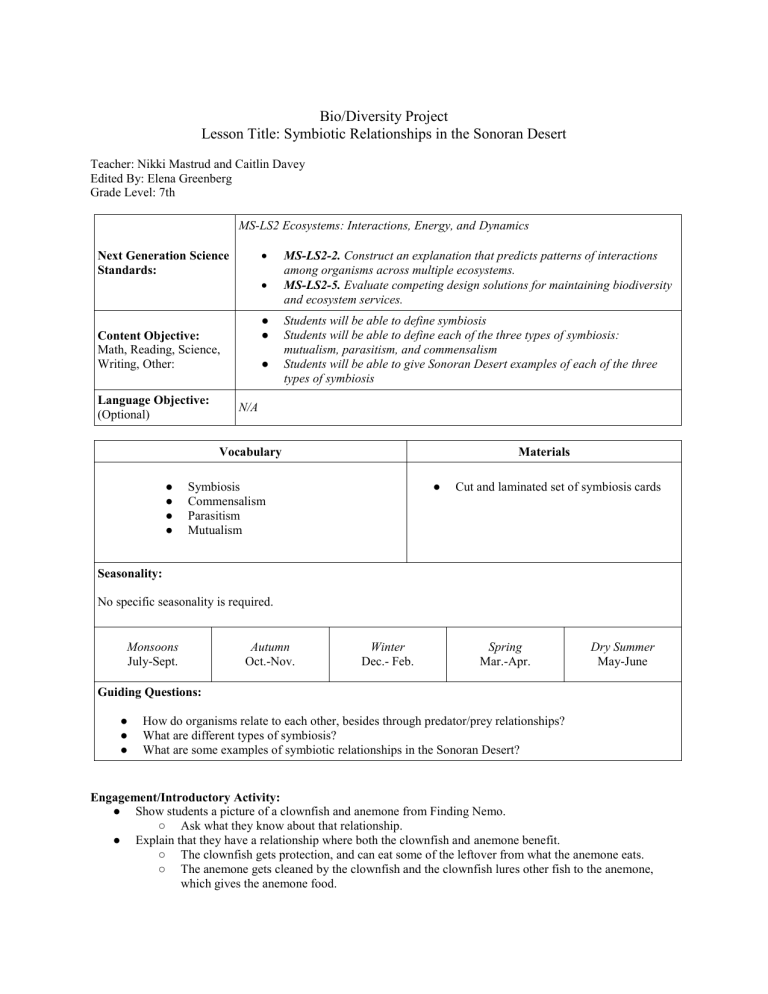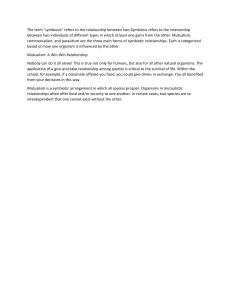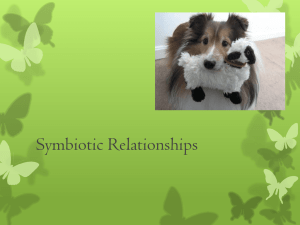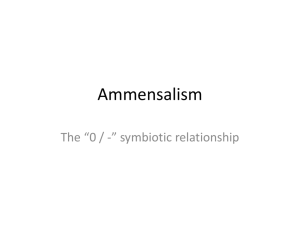
Bio/Diversity Project Lesson Title: Symbiotic Relationships in the Sonoran Desert Teacher: Nikki Mastrud and Caitlin Davey Edited By: Elena Greenberg Grade Level: 7th MS-LS2 Ecosystems: Interactions, Energy, and Dynamics Next Generation Science Standards: ● ● Content Objective: Math, Reading, Science, Writing, Other: Language Objective: (Optional) ● MS-LS2-2. Construct an explanation that predicts patterns of interactions among organisms across multiple ecosystems. MS-LS2-5. Evaluate competing design solutions for maintaining biodiversity and ecosystem services. Students will be able to define symbiosis Students will be able to define each of the three types of symbiosis: mutualism, parasitism, and commensalism Students will be able to give Sonoran Desert examples of each of the three types of symbiosis N/A Vocabulary ● ● ● ● Materials ● Symbiosis Commensalism Parasitism Mutualism Cut and laminated set of symbiosis cards Seasonality: No specific seasonality is required. Monsoons July-Sept. Autumn Oct.-Nov. Winter Dec.- Feb. Spring Mar.-Apr. Dry Summer May-June Guiding Questions: ● ● ● How do organisms relate to each other, besides through predator/prey relationships? What are different types of symbiosis? What are some examples of symbiotic relationships in the Sonoran Desert? Engagement/Introductory Activity: ● Show students a picture of a clownfish and anemone from Finding Nemo. ○ Ask what they know about that relationship. ● Explain that they have a relationship where both the clownfish and anemone benefit. ○ The clownfish gets protection, and can eat some of the leftover from what the anemone eats. ○ The anemone gets cleaned by the clownfish and the clownfish lures other fish to the anemone, which gives the anemone food. ● ● Tell students today we’ll be talking about relationship between animals besides just eating each other, such as in predator/prey relationships. These relationships are called symbiotic relationships. Have the students write the definition down in their science notebooks. ○ Symbiosis: A close relationship between two or more different organisms of different species Exploratory Activity: ● Each student will get one card like the sample on the following page. Each card will have one Sonoran Desert organism with its common and scientific names, as well as what it needs from a symbiotic relationship (examples shown at the end of this document). If there are more students than cards, some students will have duplicates. ● Each card has one other match, which is another organism that it has a symbiotic relationship with. ○ Exception is Mistletoe, which has a mutualistic relationship with Phainopepla and a parasitic relationship with Desert Ironwood ● Instruct students to get up and walk around the room with their card. They should talk to each other and find their classmate that has the matching partner organism. There should only be one partner/ person. If there is an uneven number of students, there can be a group of 3 but it should not have more than 2 species in it. ● List of organisms and interactions: ○ Mistletoe and Phainopepla, mutualism ○ Bees and Cacti, mutualism ○ Coyote and Fruit, mutualism ○ Cactus wren and Cholla Cactus, commensalism ○ Fringe-Toed Lizard and Desert Rat, commensalism ○ Creosote Bush and Holly Shrub, commensalism ○ Praying Mantis and Wasp, parasitism ○ Mistletoe and Desert Ironwood, parasitism ○ Fleas and Coyotes, parasitism Explain: ● Bring students back together and instruct them to sit with their matched partners. Have them share the pairs they came up with and the relationship between the two organisms. If they had incorrect matches, ask them to try to figure out as a class who the right pairs might be. ● Ask students if they notice any similarities and differences between all of the different pairs. What types of categories might they put the relationships into? ● Guide students towards the three types of symbiosis - parasitism, mutualism, and commensalism ○ Parasitism: A symbiotic relationship where one organism benefits and one organism is harmed ○ Mutualism: A symbiotic relationship where both organisms benefit ○ Commensalism: A symbiotic relationship where one organism benefits and one organism isn’t affected. ● This can also be expressed with emoji’s: ○ Parasitism: :)/:( ○ Mutualism: :)/:) ○ Commensalism: :)/:| ● Ask students how symbiotic relationships might affect biodiversity. If they need to be refreshed on the definition of biodiversity, have one of the students share the definition in their notebook. ○ Organisms can live in niches with symbiotic relationships ○ One theory of evolution says that variation is important because there is competition to continue building new defenses against parasites. Extension Activity/Questions: ● Show students the following video from National Geographic about a cool parasite that lives in snails: https://www.youtube.com/watch?v=Go_LIz7kTok Scientist of the Day: ● Dr. Patricia Stock is a professor at the University of Arizona ● She got her degrees in Argentina ● ● ● She is a professor in entomology (bugs) and plant sciences She studies symbiotic relationships between nematodes (worms), insects, and bacteria She works on survey projects throughout the world Evaluation Activity: ● Have students answer the following question with their partner: what is one symbiotic relationship you learned about today, and what type is it? References: https://sciencestruck.com/symbiotic-relationships-in-desert https://oimb.uoregon.edu/Documents/GK12/GK12-Fourth-Symbiosis.pdf Sample Card Pairs Common Cactus Bee Saguaro Cactus Diadasia rinconis Carnegiea gigantea Need to eat nutrients from nectar of flowers Needs its seeds dispersed by pollinators that eat its nectar






